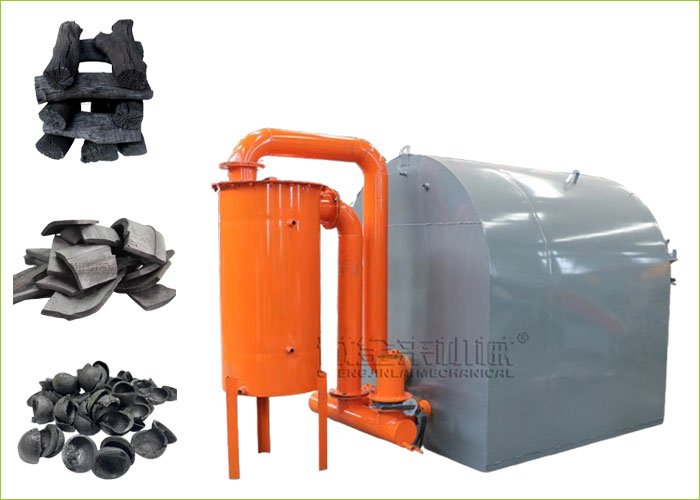Description
The Horizontal Airflow Carbonization Furnace is designed for the efficient carbonization of biomass materials such as wood, coconut shells, and sawdust. Unlike traditional methods, this furnace adopts a horizontal airflow system, which significantly improves carbonization efficiency while reducing smoke emissions. It is widely used in industries producing activated carbon, charcoal, and biochar.

Horizontal Carbonization Furnace Working Principle
The furnace operates with a high-temperature pyrolysis process. The biomass is placed in the carbonization chamber and the system uses indirect heating. The horizontal airflow ensures uniform heat distribution, thereby increasing the conversion rate and minimizing heat loss.
The flue gas generated by the internal combustion material is used for secondary heating and calcination, so that the flue gas returns to the bottom for heating. The combustion bomb heat energy can be recycled during the charcoal making process, achieving the effects of clean smoke, circulation, and fuel saving. At the same time, the acetic acid, tar, and gas generated by the material can also be collected during the carbonization process.
3 Carbonization Process
Folding carbonization furnace drying stage
From the beginning of ignition to the furnace temperature rising to 160℃, the moisture contained in the machine-made rods is mainly evaporated by external heat and the heat generated by its own combustion. The chemical composition of the machine-made rods has hardly changed;
Folding carbonization initial stage
This stage mainly relies on the combustion of the rods themselves to generate heat, so that the furnace temperature rises to between 160~280℃. At this time, the wood material undergoes thermal decomposition reaction and its composition begins to change. Unstable components, such as hemicellulose, decompose to produce CO2, CO and a small amount of acetic acid;
Full carbonization stage
The temperature of this stage is 300~650℃;

Horizontal Carbonization Furnace Machine Parameter
| Model(m) | Capacity(t/h) | Dimension(m) | Weight(kg) |
| 1.0×1.5 | 0.4t/time | 1.0×1.5×1.8 | 600 |
| 1.5×3.0 | 1t/time | 1.5×3.0×2.2 | 1800 |
| 2.0×4.5 | 2t/time | 2.0×4.5×2.2 | 3500 |
| 2.0×6.0 | 3t/time | 9.0×2.4×2.9 | 5000 |
Horizontal Airflow Carbonization Furnace Features
1. Closed quenching.
2. Continuity of production.
3. Controllable and adjustable carbonization temperature.
4. High heat transfer and wear-resistant composite materials form a high-efficiency carbonization chamber 5. All coal gas is returned to the furnace for combustion and used without waste gas pollution.
Horizontal Charcoal Carbonization Furnace Advantages
Cost-Effective – Recycled combustible gases reduce operational expenses.
Smokeless Design – Advanced gas recycling technology eliminates harmful emissions.
High Thermal Efficiency – Optimized airflow maximizes heat utilization, reducing energy waste.
Eco-Friendly Operation – Reduced emissions and efficient fuel usage make it a sustainable solution.
Large Capacity – The horizontal structure allows for batch processing, improving production efficiency.
Fast Carbonization – Uniform heating leads to quicker processing times compared to traditional methods.

Industrial tests have shown that the Horizontal Airflow Carbonization Furnace achieves a carbonization efficiency of over 90%, with a 40% reduction in fuel consumption compared to traditional kilns. Companies using this system report improved product quality and lower production costs.
Conclusion
The Smokeless Horizontal Airflow Carbonization Furnace is a superior choice for efficient, eco-friendly, and cost-effective biomass carbonization. With its smokeless operation, high efficiency, and reduced energy consumption, it outperforms traditional methods.
🔹 Interested in improving your charcoal production? Contact us now to get a quote! 🔹








